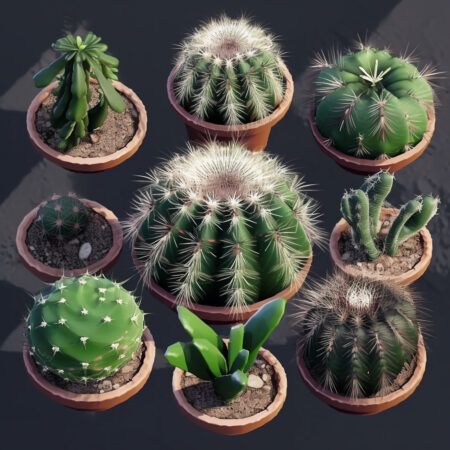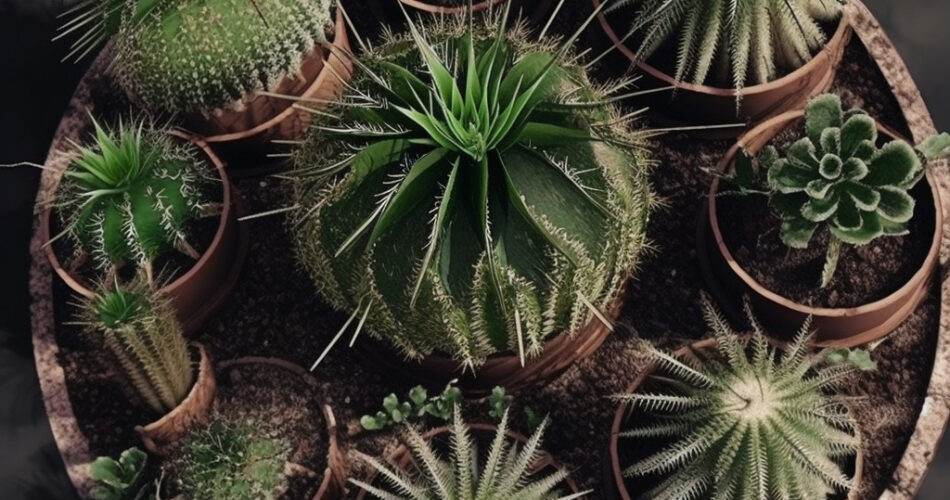Key Takeaways:
- Cacti have unique shapes, with some like Uebelmannia, standing out for their distinct appearance.
- This genus is recognized for its attractive spines and blooms.
- Native to regions in Brazil, especially in states like Bahia and Minas Gerais.
- To ensure healthy growth, it’s essential to maintain optimal soil, watering, and lighting conditions.
- Like other plants, they can be susceptible to pests, diseases, and growth issues.
- The natural habitat of these cacti includes rocky slopes and arid grasslands.
- Protecting these plants and their environment is crucial, hence the need for conservation initiatives.
- Among the various species, some are rare and hold significant value for collectors.
- Beyond their beauty, these plants play important ecological roles in their native habitats.
1. Introduction to Uebelmannia: The Unique and Enchanting World of Cacti
Uebelmannia, with their fascinating shapes and ability to thrive in harsh desert environments, have always captivated plant enthusiasts around the world. Within this diverse family, Uebelmannia stands out as a special genus, known for its unique and enchanting characteristics. In this comprehensive guide, we will explore the captivating world of Uebelmannia cacti, uncovering their origins, understanding their features, and offering valuable tips for their successful cultivation. Prepare to be amazed by the beauty and resilience of these extraordinary plants.
Exploring the Fascinating Diversity of Cacti
Before diving into the captivating world of Uebelmannia, it is essential to appreciate the vast diversity of cacti as a whole. With over 1,500 different species, cacti come in various sizes, shapes, and colors. Their ability to store water in their fleshy stems allows them to survive in arid regions where other plants struggle to thrive. From the towering giants of the Carnegiea genus to the compact and spiky Mammillaria species, cacti offer an incredible array of forms and adaptations.
Unveiling the Allure of Uebelmannia: A Special Genus
Amongst the wide range of cacti, Uebelmannia stands out for its unique beauty and fascinating characteristics. The genus Uebelmannia comprises several species native to the arid regions of Brazil. These cacti have a distinct appearance, with columnar or spherical bodies covered in distinct tubercles or ribs. Their attractive spines and vibrant flowers add to their allure, making Uebelmannia a sought-after addition to any cactus collection.
A Closer Look at Uebelmannia: The Jewel of Cacti
Discovering the Origins
To truly appreciate Uebelmannia, it is important to understand its origins. These remarkable cacti are endemic to the mountainous regions of Brazil, specifically the states of Bahia and Minas Gerais. Their natural habitat consists of rocky slopes and dry grasslands, where they have adapted to survive in the harshest conditions. The discovery of Uebelmannia in the mid-20th century sparked interest among cacti enthusiasts and collectors worldwide.
Understanding the Characteristics and Features
Uebelmannia cacti are known for their distinct characteristics and features. The plants typically have a ribbed or tuberculate surface, adorned with spines of varying lengths and colors. The tubercles play a crucial role in water storage, allowing the cacti to survive extended periods of drought. Uebelmannia also exhibit unique growth patterns, often forming solitary bodies or clustering into groups. Understanding these characteristics is essential for successful cultivation and care.
The Enchanting Beauty of Uebelmannia Flowers
One of the most captivating aspects of Uebelmannia is their stunning flowers. These cacti produce vibrant, often fragrant, blossoms in a range of colors, including shades of yellow, orange, and pink. The blooms are typically funnel-shaped or bell-shaped, attracting pollinators such as bees and hummingbirds. The ephemeral nature of Uebelmannia flowers adds to their allure, making them a cherished sight in any cactus garden.

Cultivating Uebelmannia: Tips for Successful Growth
Selecting the Right Soil and Potting Mix for Uebelmannia
Creating the ideal growing conditions for Uebelmannia starts with selecting the right soil and potting mix. These cacti thrive in well-draining soil that mimics their natural habitat. A mixture of coarse sand, perlite, and peat moss provides the perfect balance of moisture retention and drainage. Additionally, adding organic matter can help improve the overall fertility and structure of the soil, promoting healthy root development.
Providing Optimal Watering and Drainage for Uebelmannia
Watering this cactus can be a delicate process, as these cacti are susceptible to root rot if overwatered. It is crucial to strike a balance between providing enough moisture and allowing the soil to dry out between waterings. This mimics the natural rainfall patterns in their native habitat. Using the soak and dry method, where the soil is thoroughly soaked and then allowed to dry completely, is an effective watering strategy.
Creating the Ideal Lighting and Temperature Conditions for Uebelmannia
Lighting and temperature play a vital role in the successful cultivation of Uebelmannia. These cacti thrive in bright, indirect sunlight, similar to the conditions they would experience in their natural habitat. Placing them near a south-facing window or providing them with supplemental grow lights can ensure they receive the optimal amount of light for healthy growth. Temperature-wise, Uebelmannia prefer warm days and cool nights, mimicking the diurnal temperature fluctuations of their native environment.
Uebelmannia Care: Common Issues and Solutions
Preventing and Treating Pest Infestations
Like all plants, Uebelmannia are susceptible to pest infestations. Common pests that may affect these cacti include mealybugs, scale insects, and spider mites. Regularly inspecting the plants for signs of infestation and promptly addressing any issues is crucial. Natural remedies such as neem oil or insecticidal soaps can help control pests, while proper hygiene and quarantine measures can prevent the spread of infestations.
Identifying and Managing Common Diseases Affecting Uebelmannia
While this cacti are generally resilient plants, they can still be affected by certain diseases. Overwatering can lead to root rot, causing the plant to decline. Fungal infections such as powdery mildew or stem rot can also occur if the environmental conditions are not ideal. Carefully monitoring watering practices, providing proper ventilation, and avoiding excessive humidity can help prevent these diseases.
Troubleshooting Growth Problems in Uebelmannia
If your Uebelmannia is experiencing growth problems, it is essential to identify and address the underlying issues. Common growth problems include stunted growth, yellowing or browning of the plant, and wilting. These issues can be caused by factors such as incorrect watering, nutrient deficiencies, or insufficient light. Adjusting the care routine, providing necessary nutrients, and ensuring optimal growing conditions can help revive a struggling cactus.
Uebelmannia in the Wild: Exploring Natural Habitats
Exploring the Native Regions of Uebelmannia
To truly appreciate Uebelmannia, it is essential to explore their native regions in Brazil. These cacti are primarily found in the states of Bahia and Minas Gerais, within the Caatinga and Cerrado biomes. These regions are characterized by rocky slopes, dry grasslands, and unique flora and fauna. Visiting these areas allows for a deeper understanding of the natural habitats of this cactus and the challenges they face in the wild.
Observing the Unique Adaptations of Uebelmannia in the Wild
The harsh conditions of their natural habitats have led to unique adaptations in Uebelmannia. These cacti have developed mechanisms to conserve water, such as reducing surface area through tubercles and spines. They have also evolved to rely on specific pollinators for reproduction. Observing these adaptations firsthand provides a greater appreciation for the resilience and survival strategies.
Conservation Efforts for Protecting Uebelmannia and Its Ecosystem
As habitat destruction and illegal collection pose significant threats to this cactus populations, conservation efforts are crucial for their survival. Organizations and botanical gardens are actively working to protect these cacti and their ecosystems through initiatives such as habitat restoration, educational programs, and captive breeding programs. By supporting these efforts, individuals can contribute to the long-term conservation of Uebelmannia and other endangered plant species.
Uebelmannia as a Collectors’ Delight: Rare and Valuable Species
Uncovering Rare and Endangered Varieties
Within the Uebelmannia genus, there are several rare and endangered species that are highly sought after by collectors. These include Uebelmannia buiningii and Uebelmannia pectinifera, which are known for their distinctive features and limited availability in cultivation. Obtaining these rare varieties requires adherence to legal and ethical collection practices, as well as a commitment to supporting conservation efforts.
The Thrill of Uebelmannia Collection and Propagation
For plant enthusiasts and collectors, this cactus offer an exciting opportunity to explore and expand their collections. Propagation techniques such as seed sowing, offset division, and grafting can be used to propagate these cacti successfully. The process of collecting, propagating, and nurturing it can be incredibly rewarding, allowing enthusiasts to witness the growth and development of these unique and valuable plants.
Appreciating Uebelmannia as a Unique and Valuable Plant
Beyond their appeal to collectors, Uebelmannia holds immense value as a unique plant species. Their ability to survive in harsh desert environments and their beautiful flowers make them a fascinating addition to any garden or botanical collection. Furthermore, this cacti serve ecological functions, providing habitat and food sources for various organisms in their native ecosystems. Appreciating and protecting these remarkable plants is essential for their long-term survival and the preservation of biodiversity.
FAQ
Question: What makes these cacti unique?
Answer: They have distinct appearances with columnar or spherical bodies, intricate spines, and vibrant flowers that set them apart from many other cacti varieties.
Question: Where is their natural habitat?
Answer: These cacti are native to the rocky terrains and arid regions of Brazil, predominantly in states like Bahia and Minas Gerais.
Question: What are the ideal conditions for their growth?
Answer: They flourish in well-draining soil that replicates their original habitat, under bright indirect sunlight, with notable temperature fluctuations throughout the day.
Question: How should they be watered?
Answer: Watering should be done using the soak and dry method, letting the soil thoroughly dry out in between to avoid any root issues.
Question: Which pests are they commonly susceptible to?
Answer: These cacti can often fall prey to mealybugs, scale insects, and spider mites.
Question: Can they contract any diseases?
Answer: They can become vulnerable to various diseases like root rot or stem rot, especially when not in the ideal environment.
Question: Where can one find them in the wild?
Answer: Their presence is mainly marked within the states of Bahia and Minas Gerais in Brazil, predominantly in specific biomes like Caatinga and Cerrado.
Question: Are certain species considered rare or valuable?
Answer: Indeed, some species like buiningii and pectinifera are rare and sought after by enthusiasts and collectors.




Comments